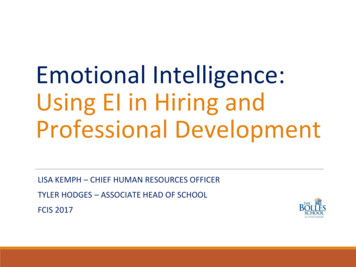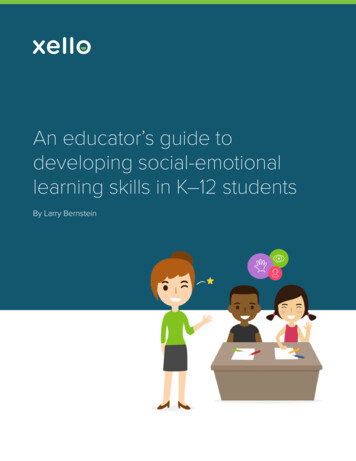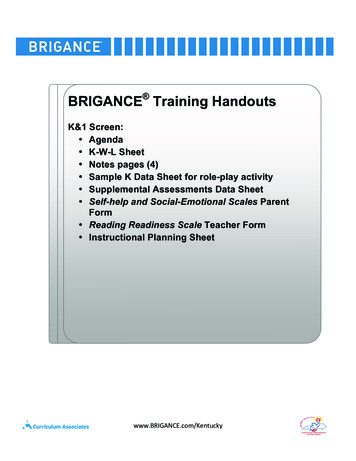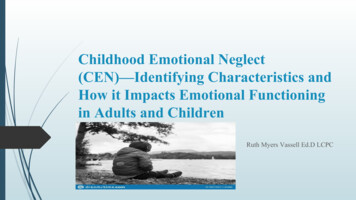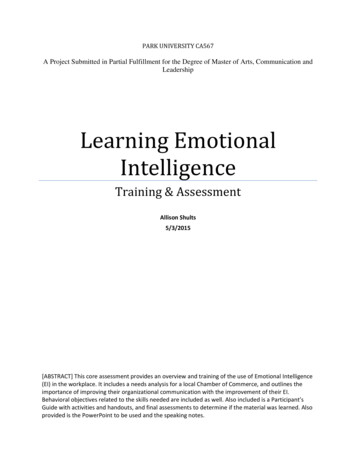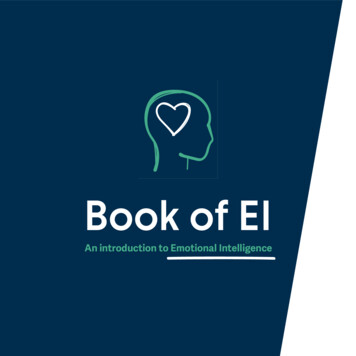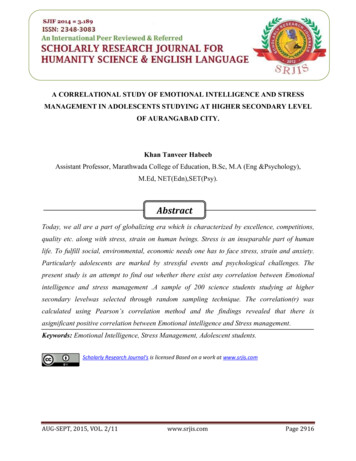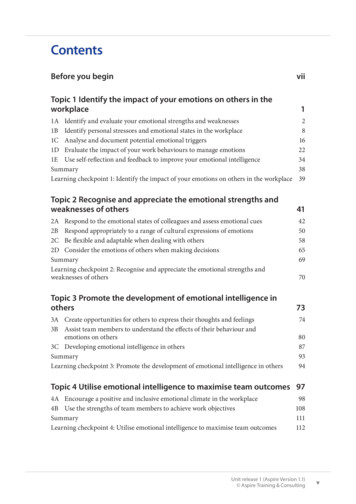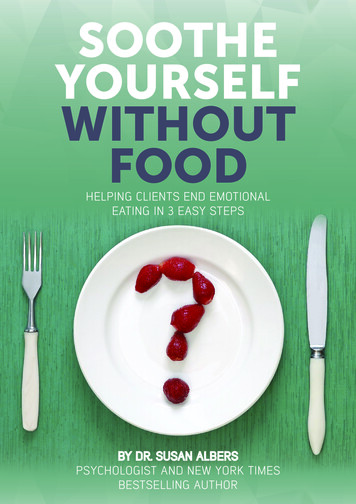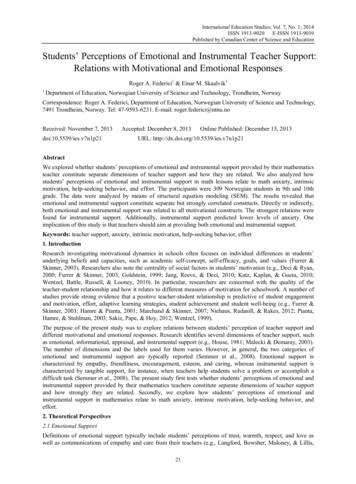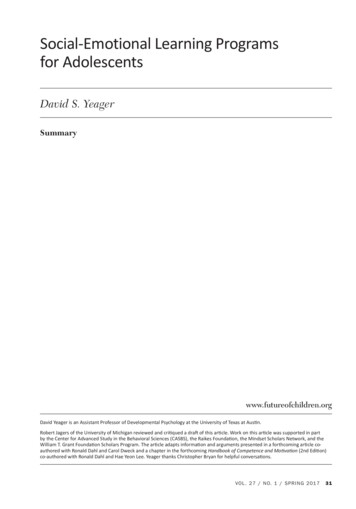
Transcription
Social-Emotional Learning Programs for AdolescentsSocial-Emotional Learning Programsfor AdolescentsDavid S. YeagerSummarywww.futureofchildren.orgDavid Yeager is an Assistant Professor of Developmental Psychology at the University of Texas at Austin.Robert Jagers of the University of Michigan reviewed and critiqued a draft of this article. Work on this article was supported in partby the Center for Advanced Study in the Behavioral Sciences (CASBS), the Raikes Foundation, the Mindset Scholars Network, and theWilliam T. Grant Foundation Scholars Program. The article adapts information and arguments presented in a forthcoming article coauthored with Ronald Dahl and Carol Dweck and a chapter in the forthcoming Handbook of Competence and Motivation (2nd Edition)co-authored with Ronald Dahl and Hae Yeon Lee. Yeager thanks Christopher Bryan for helpful conversations.VOL. 27 / NO. 1 / S PR ING 201731
David S. YeagerAdolescence is a periodof tremendous learning,exploration, and opportunity.Yet it’s also a time whenbehavioral and health problemscan emerge or worsen, with negativeconsequences that last long into adulthood.For instance, people who are victimized orbullied during adolescence can later becomemore aggressive and more depressed.1Extreme school-discipline policies canpush young people toward delinquency asadolescents and toward criminal behavior asyoung adults, even if they weren’t inclined tobe delinquent before (a phenomenon calledthe school-to-prison pipeline).2 And failingto complete high school on time predictslower health, wealth, and happiness over thelifespan, even for people who later earn aGED.3Social and emotional learning (SEL)programs for adolescents are appealingin part because they may prevent suchproblems. SEL programs try to helpadolescents cope with their difficulties moresuccessfully by improving skills and mindsets,and they try to create respectful schoolenvironments that young people want to be apart of by changing the school’s climate.Adolescents may especially need this kindof social and emotional help. Just whenacademic work becomes more difficult andfriendships become less stable, the brain’smethod of processing emotions undergoesa dramatic transformation.4 The onset ofpuberty—which marks the beginning ofadolescence—causes changes in brainstructure and hormone activity that canmake even minor social difficulties likepeer rejection extremely painful and hardto deal with.5 Those biological changesalso create a more intense thrill from risky32T H E F U T UR E OF C HI L DRE Nbehavior, especially when it may win peers’admiration.6 Last, adolescents expect moreautonomy and independence in personalchoices like whom to be friends with.7 Insum, adolescents are learning how to handlenew demands in school and social life whilelearning to deal with new, intense emotions(both positive and negative), and increasinglyfeeling like they should do so without adultguidance. SEL programs are one way to helpthem navigate these difficulties.But do SEL programs work for adolescents?If so, how well and under what conditions?And how can they be improved? This articlereviews these questions. Here are themain takeaways. First, effective universalsocial-emotional learning can transformyoung people’s lives for the better. Effectiveprograms can prevent catastrophic outcomes,such as unwanted pregnancy, arrests forviolent crime, or dropping out of high school.They can also encourage greater thriving,including having less stress, better health,and a greater love of learning.8 Improvingadolescents’ interior social and emotionallives can spill over into other areas offunctioning, because social and emotionallife matters so much at this age. Given thatthe same programs can sometimes affectmany different outcomes, effective universalSEL can be economically efficient.9Second, and less encouragingly, typical SELprograms, which directly teach adolescentsskills and invite them to rehearse those skillsover the course of many classroom lessons,have a very poor track record with middleadolescents—roughly age 14 to 17—eventhough they work with children. Programsfor adolescents are sometimes simplyaged-up versions of childhood programs—for instance, they communicate the samemessage, but now the character doing
Social-Emotional Learning Programs for Adolescentsthe talking has a skateboard and a chainwallet. Such programs often fail to captureadolescents’ attention, both in what they sayand how they say it. The evidence is clear: wecan’t rely on an elementary-level, classroombased, social-skill-training program revampedfor middle adolescents. The story is less clearfor early adolescents, roughly age 10 to 14.Before eighth grade, adolescents sometimesbenefit from direct-instruction programs.However, even these younger adolescentsmay benefit more from programs that aremore “adult-like”—indeed, early adolescencemay be an excellent time for wiser socialemotional programming.Third, effective programs make adolescentsfeel respected by adults and peers andoffer them the chance to gain status andadmiration in the eyes of people whoseopinions they value. Ineffective programs dothis less well or focus on factors that matterless, such as knowledge of risks, planning, orgoal setting. This means that new programsmight use different tactics: they might aim tomake the good and healthy choice also feellike the “awesome” choice.BackgroundEarly and Middle AdolescenceAdolescence begins at puberty and endswith independence from adults. In thisarticle, I call childhood the elementaryyears before fifth grade, early adolescenceroughly fifth to seventh grade, and middleadolescence roughly eighth to 12th grade.I say “roughly” because these labels areimprecise. Adolescents begin puberty at verydifferent times. Girls mature earlier thanboys, and even within genders it’s normalfor people to begin puberty two to threeyears apart. Moreover, different racial andethnic groups in the United States tend tostart puberty at different times. For instance,it is normal for African American girls tobegin puberty at age 7 or 8; white and AsianAmerican girls often begin several yearslater.10 Until more SEL program evaluatorsmeasure indicators of pubertal status, suchas secondary sex characteristics or levels ofthe hormones testosterone or estradiol, itwill be hard to separate biological maturationfrom chronological age and school year whentrying to understand why programs showdifferent effects at different ages.Contrary to popularstereotypes, testosterone isn’tan aggression hormone, andit isn’t purely a sexual-desirehormone. It’s also a statusrelevant hormone.What Changes during Adolescence?The onset of puberty means that adolescentspay more attention to social cues that signalpossible threats to status or respect, andthey exhibit greater reactivity to feedbackabout status or respect (thrill of pride oradmiration, fear of humiliation or shame, oranger at unfairness). They also experienceincreased motivation to engage in sociallearning situations relevant to status andrespect (those that create acceptance).11HormonesPubertal maturation leads to increases orchanges in the functioning of a numberof hormones, including testosterone,estradiol, cortisol, oxytocin, anddehydroepiandrosterone (DHEA-S).12 AllVOL. 27 / NO. 1 / S PR ING 201733
David S. Yeagerof these hormones are related to socialand emotional functioning, but so far,testosterone has shown the clearest link towhat SEL programs might typically do rightor wrong.In both males and females, pubertalmaturation leads to a surge in theproduction of testosterone. Contrary topopular stereotypes, testosterone isn’t anaggression hormone, and it isn’t purelya sexual-desire hormone. It’s also astatus-relevant hormone. When people’stestosterone levels are high, they’re morelikely to focus their attention on markersof status and to respond powerfully whentheir status is on the line.13 For example,one study found that testosterone predictsaggressive behavior when boys have deviantfriends but leadership when they don’t—demonstrating how it focuses attention onthe criteria for status.14Psychological NeedsAlong with biological changes, adolescentsexperience psychosocial changes. BradfordBrown, a developmental psychologist at theUniversity of Wisconsin, wrote in a reportfor the National Academy of Sciences thatadolescents have four developmental tasks:151. To stand out: to develop an identityand pursue autonomy;2. To fit in: to find comfortableaffiliations and gain acceptancefrom peers;3. To measure up: to developcompetence and find ways toachieve, and4. To take hold: to make commitmentsto particular goals, activities andbeliefs.34T H E F U T UR E OF C HI L DRE NWhen SEL programs honor adolescents’desire to achieve these tasks—that is,when they respect the kind of person anadolescent needs and wants to be—they cancapture adolescents’ motivation to change.When programs threaten that desire,instead, they may not change behavior.Skills, Climate, and MindsetsDifferent people sometimes mean verydifferent things when they talk about SELprograms. One perspective is that the childneeds to be changed—that the child’s skillsneed to be supplemented or revised insome way, and the program will teach thechild to do that. This is the skills model.Another perspective is that the environmentneeds to be changed—that the teachersand other grown-ups in the school needto change the emotional climate to be lessnegative and more supportive. This is theclimate model. Research offers evidencefor and against both. One perspective sitsbetween the two: the mindsets model.Environments can socialize children andadolescents to hold different belief systems,or mindsets.16 These mindsets in turn causethem to use (or not use) the skills that theyhave or are acquiring.In general, the skills model of SEL seemsless effective with adolescents than it is withyounger children. The climate model can bepowerful, but it doesn’t always translate intopositive behavior when children leave theaffected climate (for example, when they’reout of school and on their own, or afterthe program ends). The mindsets modelis promising for producing internalized,lasting change, because it’s a mentalmodel that stays with people over time.The evidence I present below suggeststhat the ideal is to create a supportive
Social-Emotional Learning Programs for Adolescentsemotional climate that also teaches youngpeople mindsets they can apply when theyeventually leave that climate.Grounding Examples from DiverseDomainsLet’s consider concrete examples of thedifficulties and potential inherent inadolescent SEL programs. The examplescome from very different areas: teenpregnancy, youth violence, teen smoking,and medical adherence.Teen PregnancyMany programs to prevent teen pregnancytell youth that adults don’t condone orallow teenage sex. Abstinence-only trainingis one such example; others are programsthat teach skills for refusing sex. In metaanalyses (studies that aggregate the resultsof many individual experiments to makeoverall statements), these skill-basedprograms have often shown no reductions inteen pregnancy.17But Teen Outreach, a volunteer serviceprogram for ninth to 12th graders, led tosignificant reductions in teen pregnancy.18Although less than 15 percent of its contentinvolved discussions of sex—and in manyschools, the content on skills for safe sexwas not even delivered—Teen Outreachreduced the rate of pregnancy (for girls)or responsibility for pregnancy (boys)from 9.8 percent to 4.2 percent. It alsohad impressive side effects; it improvedacademic behavior, reducing suspensionsfrom 29 percent to 13 percent and coursefailure rates from 47 percent to 27 percent.These kinds of benefits have appearedin numerous evaluations. Some recentreplications found weaker benefits, butthere were problems with those studies; forinstance, in the replications the researchersgave aspects of the treatment to the controlgroup, and so the two groups didn’t differ atfollow-up.19Although Teen Outreach taught skills,skills training wasn’t its core. High schoolstudents participating in the programdid about 35 hours of community serviceover one year, thus working to make theircommunities better. Simultaneously, intheir health classes they received trainingin areas like self-confidence and social skillsthat could help them serve the communitymore effectively. The program didn’timply that “you need skills because thereis something wrong with you.” Instead,it began with the assumption that youngpeople want to matter—they want to dosomething of consequence for the worldaround them, and they want to have acoherent life story. Adolescents were willingto learn social skills as long as doing soserved the broader purpose of mattering.Presenting skills training in this way canavoid the disrespectful implication thatadolescents need such training because of adeficiency.Youth ViolenceThe Quantum Opportunity Program was afour-year after-school program that taughtlow-income high school students about theimportance of staying out of trouble withthe law.20 It also taught youth about longterm the risks of unhealthy substance-useand sexual behaviors, paired them withadult mentors to coach them in life skills,and gave them financial incentives forattending the sessions and carrying outhealthier behaviors. It seemed to involveeverything needed to keep young peopleon track. But 10 years after the programVOL. 27 / NO. 1 / S PR ING 201735
David S. Yeagerended, male participants were more, ratherthan less, likely to have been arrested.21Contrast this to Becoming a Man (BAM),a weekly school-based discussion groupthat produced dramatic effects.22 BAMreduced arrests among participants by28 to 35 percent and violent crime by 45to 50 percent, and increased high schoolgraduation by 12 to 19 percent at long-termfollow-up. BAM doesn’t ask young men tosuppress their desire to fight or retaliatewhen they are disrespected on the street.BAM doesn’t tell young people what theyhave to do, or what’s right or wrong; it evenacknowledges that sometimes it is importantto retaliate to protect one’s reputation. Butthe program helps young men find otherways to save face and maintain their statuswhen confronted with a threat. It gives thema new mindset for interpreting threats, andit helps them develop different ways to bemasculine, such as focusing on integrityand personal accountability. BAM featuresopen-ended, student-led discussions withmentors from the neighborhood, along witha series of activities that build relationshipsand a sense of community with others in asmall group. It also involves an appealingact of defiance: students have to skip class toattend. Paradoxically, skipping class to attendBAM led to higher graduation rates. Overall,BAM is a respectful way of reducing youthviolence in Chicago.school’s culture through advertisements,promotions, assemblies, and more. Yet alarge, randomized evaluation of a programthat used this skills model found few if anybenefits among 12- to 15-year-olds—a findingmatched by many other similar studies.23Paradoxically, skipping classto attend BAM led to highergraduation rates.But SEL programs can include messages thatharness adolescents’ deepest motives—theirdesire to attain respect and status in theeyes of peers or adults whose opinions theyvalue. In the early 2000s, one antismokingcampaign did this—the well-known truth campaign.24 This campaign didn’t emphasizethe long-term health consequences ofsmoking, nor that adults believe teensshouldn’t smoke. Instead, it depictedrebellious, autonomous adolescents floodingthe streets, screaming into megaphonesat rich, old tobacco executives in high-risebuildings in Manhattan, telling them to “takea day off” from tricking and harming childrenfor the sake of profit. In rigorous policyevaluations, this campaign was effective atchanging smoking behavior; one evaluationestimated that in its first four years, it kept450,000 adolescents from starting to smoke.2SmokingAdherence to Cancer TreatmentAn enormous amount of research in publichealth has sought ways to reduce teensmoking via programs that teach social oremotional skills. Such programs have (1)emphasized the long-term consequencesof smoking, (2) directly taught refusalskills, or (3) tried to change the wholeAdolescents often reject SEL programsthat aim to improve their mental health.But with surprising frequency, they alsoreject unpleasant or inconvenient behaviorsthat could improve their physical health.In a hospital, doctors and nurses canforce adolescents to complete treatment.36T H E F U T UR E OF C HI L DRE N
Social-Emotional Learning Programs for AdolescentsYet after they leave the hospital, abouthalf of adolescent cancer patients choosenot to complete regimens of painfulself-administered drugs, such as oralchemotherapy.26 (Younger children, bycontrast, are much less likely to rebel againsttheir chemotherapy regimen.27) A tried-andtrue method from the skills model of SELprograms—explaining to adolescents thelife-or-death consequences of their choices—hasn’t changed such patients’ behavior.align the adult-sanctioned healthy choice—not getting pregnant, not getting arrested,etc.—with peer-sanctioned sources of statusand respect like freedom, autonomy, ormattering. These programs do this both inhow they talk to young people—by offeringopportunities for authentic choice andinput—and in what they teach—by helpingyoung people envision a desirable futureas the kind of person who makes healthychoices.The mindsets method offers an alternative.One program sought to change the meaningof adherence to chemotherapy, fromsomething that was seen as compliant andunder adult control to something that wasseen as rebellious and autonomous. In thevideo game Re-Mission, adolescents controla robot that drives inside the body of acancer patient and destroys cancer cells.28In the game, participants ensure that thehuman cancer patient their robot inhabitspractices positive self-care, such as takingchemotherapy and antibiotics. Complianceis framed as a way to rebel against theunwanted attacks of cancer cells, rather thanlistening to adults’ warnings about long-termhealth. In a randomized evaluation withabout 370 cancer patients, adolescents whoplayed Re-Mission were more likely to chooseto take their chemotherapy pills and alsoreported greater self-efficacy in doing so.29Disappointing Effects of SkillBuilding SEL ProgramsSummaryWhat do these effective programs I’vedescribed have in common? They’re notbased on the skills model, even though theysometimes teach skills. Instead, they findways to motivate young people in terms ofthe values that matter most to them, andthey try to change how young people see theworld—their mindsets. Effective programsAre the ineffective programs I describeabove isolated examples? Unfortunately,no. After a recent review of SEL programs,Nobel laureate James Heckman andTim Kautz at the University of Chicagoconcluded, “Programs that targetadolescents have not been established to beas effective as programs that target earlierages.”30 Similarly, in a recent review forpolicymakers, adolescence expert LawrenceSteinberg wrote that “classroom-basedhealth education is an uphill battle againstevolution and endocrinology, and it is not afight we are likely to win.”31What kinds of findings lead to suchconclusions? One helpful method is metaanalysis, which can prevent any individualstudy from exerting too much influence.One of the most prominent meta-analysesof SEL programs reviewed 213 schoolbased, universal social and emotionalprograms delivered from Kindergarten to12th grade.32 It found that older adolescentsaltered their social-emotional skillssubstantially less than younger children did.Or consider universal prevention programsfor obesity. These programs typicallyteach a variety of thinking skills and newVOL. 27 / NO. 1 / S PR ING 201737
David S. Yeagerhabits for coping with temptation, whileemphasizing the desirability of long-termhealth. A prominent meta-analysis of 64programs found that they were effectivefor children younger than 11 but not foradolescents.33 In fact, 12- to 15-year-oldswho received an anti-obesity programgained more weight than those who didn’t.Similarly, the average effect of universaldepression-prevention programs forhigh school students was found to benonsignificant.34 Similarly, a meta-analysisof 28 studies involving 19,301 young peopleages 12 to 16 found that programs to reducerecidivism among juvenile delinquents hadno significant overall benefits.35A more informative test would comparethe same programs across different agegroups in the same evaluation study.One evaluation of the effects of schoolbased mentoring did this.36 A total of516 predominately Latino students inelementary, middle, and high school wererandomly assigned to receive a mentorwho met with them at schools an averageof eight times. The authors found thatalthough the mentoring program benefitedboys’ psychosocial outcomes (empathy,cooperation, and connection to teachers)in elementary school, mentoring led toharmful effects for high school boys.A recent meta-analysis of 72 programeffects that I conducted looked at howanti-bullying programs’ efficacy changedwhen delivered at different ages.37 Fromkindergarten to seventh grade, anti-bullyingprograms were beneficial, on average. Butwhen the same programs were delivered ineighth grade or above, the average effectfell to zero. In fact, the estimated effect ofthe average anti-bullying program in high38T H E F U T UR E OF C HI L DRE Nschool was a small increase in bullying.Traditional programs often work less wellwith adolescents, and eighth grade maymark a turning point in their efficacy. Whenevaluating a program, I recommend lookingfor whether it works specifically withmiddle adolescents (eight grade and above).Unfortunately, many program evaluationssimply report the effect for middle school(sixth to eighth grade), overall. This meansthat school districts may sometimes scaleprograms for their older youth, when in factthe evaluation-effect size was buoyed by abenefit for sixth graders.Adolescents might find itcondescending to be giveninformation they alreadyhave. For example, mostteens already know thatsmoking is harmful.CaveatsIn this discussion, I don’t mean to say thattraditional programs have never workedwith older adolescents, or that they can’twork in the future. I’m simply saying that,on average, they haven’t yet worked reliably.A few other cautions are in order. For onething, many studies’ outcome measureshave relied on participants’ self-reporting.These studies would be more compellingif direct measurements of behaviorshowed the same results. Still, studiesthat measured behavior generally showedthe same discouraging results. Also, manystudies didn’t compare the same program
Social-Emotional Learning Programs for Adolescentsdelivered at different ages—only theanti-bullying and mentoring studies did.Therefore, the age trends I’ve discussedaren’t definitive.Last, these studies don’t consider thepossibility of sleeper effects, that is,beneficial effects that show up later, in earlyadulthood. Indeed, one prominent SELintervention study found just such effects.38That’s why researchers like Heckmanhave called for more studies that followadolescents as they grow older.39Troubleshooting Failed InterventionsWhy might programs be less effective formiddle adolescents than for elementary-agechildren? Four explanations are plausible.First, it’s tempting to think that typicalprograms aren’t long or comprehensiveenough. If adolescents are novices inthe skills they’re being taught in SELprograms, then perhaps the more theypractice those skills, the more expertisethey’ll acquire. However, data offerlittle support for this claim. In fact, twometa-analyses (of obesity and depressionprevention programs) by Eric Stice andhis colleagues at the Oregon ResearchInstitute found that shorter programs hadstronger effects.40 Likewise, one group ofresearchers found no effects for a long andcomprehensive training program to preventteen smoking, but much stronger effectsafter the researchers reduced its length bytwo-thirds.41 One reason for these resultsmay be that adolescents feel stigmatized bylong programs that teach them what seemlike basic social skills. They might also findit condescending to be given informationthey already have; for example, most teensalready know that smoking is harmful.42Second, it’s also possible to think that socialemotional skills are no longer malleable byadolescence. But although early childhooddoes provide a “sensitive period” forsome brain and stress-response systems,neuroscientists now agree that adolescenceis a second window of opportunity fordevelopment, especially in the social andemotional domain.43For example, Edith Chen and GregoryMiller, psychologists who specialize in howbiology contributes to health, have found thatchildhood poverty is often a better predictorof later health problems than adolescentpoverty, which could seemingly imply thatthe damage is done after a certain age.44 Yetin the same studies, among adolescents whodeveloped strong, supportive ties to familyor who developed mindsets in which theydidn’t see the world as threatening, childhoodpoverty didn’t predict poor outcomes.45Adolescents have the ability to form newsocial relationships or adopt new mindsetsthat buffer against stress, and effective SELprograms can help provide those things.46Third, it’s plausible that even if socialemotional skills are malleable duringadolescence, typical programs could betargeting the wrong skills. Maybe traditionalprograms are simply targeting skills thatare less relevant to the effects they seek toproduce—on grades, school dropout, stressand coping, and depression, etc.—than theyare in early childhood.Take the case of anti-bullying interventions.The underlying theory for many antiaggression programs is that students areaggressive because they lack social oremotional skills. However, summaries ofmany past studies show this is true primarilyfor younger children. Among middleVOL. 27 / NO. 1 / S PR ING 201739
David S. Yeageradolescents, peer aggression is predictedby social and emotional strengths, such asincreased perspective taking, greater socialinfluence, or high popularity.47 Harmingothers’ reputations through rumors orexclusion, which is what high school studentsoften do, takes a certain amount of socialsavvy, while punching people—what youngchildren do—does not.Fourth, SEL programs may targetmeaningful, malleable skills but do so in waysthat teens don’t internalize—that is, theymay not show a willingness to implement theskill or mindset in a different setting whenthey don’t have to. Indeed, the neural andhormonal changes at the onset of pubertysuggest that when the thrill of social successand the agony of public humiliation feeloverwhelming, adolescents may be onthe alert for quickly shifting attention andmotivation.48 Traditional methods of behaviorchange may sometimes force adolescentsto choose between uncertain physical harmin the future (dying of lung cancer) and thefeeling of certain social death in the present(humiliation before one’s peers). Moreeffective methods can frame a behavior in away that lets adolescents opt for both futurehealth and the immediate feeling of socialrespect, as Teen Outreach, BAM, truth ,and Re-Mission do.For instance, adolescents in one recent studywho watched video clips of their motherstelling them how they should change theirbehavior (for example, by cleaning theirroom, taking their shoes downstairs, or beingnice to their siblings) showed a pattern ofneural activity that suggested they weren’tprocessing the criticism or planning to altertheir behavior.49 Specifically, in responseto maternal criticism, regions of the brainrelevant to anger were activated while40T H E F U T UR E OF C HI L DRE Nregions relevant to processing information andmaking plans showed blunted activation.Yet not all adult-provided experiences elicitstrong negative responses from adolescents.Recall the example of the Re-Mission videogame, which increased adherence to a regimenof unpleasant cancer drugs. When researchersused functional magnetic resonance imaging(fMRI) to scan adolescents’ brains while theyplayed Re-Mission, the researchers foundthat game play activated neural circuitsassociated with intrinsic reward.50 Adolescentsfelt pleasure when they were able to maketheir own choices and discover for themselvesthe consequences of their actions. Suchneural circuits are known to be highly active,especially during adolescence, and they createa strong intrinsic motivation to learn andinternalize an SEL message if it offers choiceand exploration.51In general, when SEL programs feel toadolescents like a mother telling them howto make their personal choices, null effectsshouldn’t surprise us. But when SEL programsoffer adolescents a route to feelings of statusand respect, it’s likely that they’ll internalizedacquired skills and apply them in the realworld.Climate and Mindset ApproachesNext, I review several studies that used theclimate and mindset approaches to improveadolescent SEL outcomes. They illustrate waysto create climates that are more respectful,or mindsets in which adolescents perceivethat healthy choices confer status or that peerconflicts are less disrespectful. They take threeapproaches:1. Creating a mindset that harnessesthe adolescent desire for status andrespect.
Social-Emotional Learning Programs for Adolescents2. Creating a climate that’s morerespectful toward adolescents.3. Creating a mindset that blunts thepower of threats to peer status andrespect.The cases I discuss target different domains:academic achievement, healthy eating, schooldiscipline, and aggression in response to peervictimization. Since these cases representrelatively new approaches, the interventionsare more limited in scope and the data aresometimes from sho
problems. SEL programs try to help adolescents cope with their difficulties more successfully by improving skills and mindsets, and they try to create respectful school environments that young people want to be a part of by changing the school's climate. Adolescents may especially need this kind of social and emotional help. Just when
